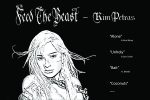Unlike the majority of entertainers in the music industry today, Solange Knowles, Beyoncé’s younger sibling and Jay-Z’s sister in law, creates art for the sole purpose of expressing her most genuine self.
Instead of trying to please others, she focuses on producing work that reflects the stylistic freethinking she feels on the inside. Evidently, she is staying true to the promise she made to Billboard last year when she said she was “not interested in entertainment at this moment.” The result is wholesome lyrics and harmonies that often call for an acquired taste to fully enjoy.
At midnight on March 1, at the precise crossroads of Black History Month and Women’s History Month, Solange strategically dropped her fourth studio album, “When I Get Home.” Over the course of 39 minutes and 19 tracks, she pays homage to her individuality through the exploration of race, gender, divinity and her hometown, Houston, Texas.
Race
In the songs “Almeda,” “My Skin My Logo,” “Down With the Clique” and “Stay Flo,” Solange reiterates the pride she finds in her heritage, while remembering the obstacles her ancestors had to face to propel her to the position she finds herself in today.
https://www.instagram.com/p/Buu0iacgMY3/
Using repetition to reinforce her personal messages about life, Solange sings “Brown liquor, brown liquor / Brown skin, brown face / Brown leather, brown sugar / Brown leaves, brown keys / Brown zippers, brown face / Black skin, black braids / Black waves, black days / Black baes, black days / These are black-owned things … ” listing the beautiful aspects of life credited to black hands.
Before releasing “When I Get Home,” Solange took over the website Black Planet to tease the music directly to the community it will resonate with the most.
One of the most influential aspects of Solange’s music is the unapologetic ways she turns her background into something that makes her powerfully distinguished. Embracing who she is entirely, she told Complex, “Blackness will never go away, I will always create work from this black body.”
Gender
“When I Get Home” captures the experiences of black women in a very contemporary way. Solange discusses overcoming her vulnerabilities about gender and allowing them to empower her instead with the songs “Dreams,” “Binz” and “Jerrod.”
Singing about how she grew up as a little girl with big dreams, Solange delves into the truth about how tough it can be to let dreams live on even after they have “come undone” and transform along the way.
In “Binz,” Solange indulges in fantasies of waking up with a life of luxury that no one can question no matter what her race and gender may be. Being in the industry with one of the biggest wage gaps between genders, female entertainers are finally taking a stand and raising their voices about inequality.
“Jerrod” intentionally sounds provocative, as it shifts the typical power dynamic between males and females in the latter’s favor. Although women are usually considered the weaker sex, this song analyzes the depth they offer their partners. Solange affirms that she feels most influential when she takes care of the woman within her soul.
Divinity
Solange is known for her belief in the power of manifestation or, in other words, the ability to visualize your dreams and make them a reality.
This can clearly be seen in the song “Things I Imagined” and the interludes “Can I Hold the Mic” and “Nothing Without Intention.”
She introduces a mantra in the album’s intro track when she chants “I saw things I imagined,” painting a picture of the ways she turns the vision of the person she wants to become into the image of her real life.
In “Can I Hold the Mic (interlude),” Solange delivers a moving speech about accepting every facet of your being, even the parts you desperately wish you could change. Solange’s words speak volumes and resonate with every listener, regardless of race, gender and personal beliefs. “I can’t be a singular expression of myself / There’s too many parts, too many spaces,” she sings, “Too many manifestations, too many lines / Too many curves, too many troubles / Too many journeys, too many mountains / Too many rivers, so many.”
“Nothing Without Intention” reminds listeners to stay true to themselves and never lose sight of where they’re going, or where they came from.
Hometown
It’s no secret that Solange’s hometown of Houston, Texas, holds a special place in her heart. The artist has confessed that, despite the world around her constantly evolving, she continues to yearn for a few simple things in life that remain the same.
No matter what happens in the younger Knowles’ sister’s life, she can count on returning to Houston and feeling at peace. In fact, she constructed this entire tape from a quiet home she rented in Third Ward, the neighborhood she grew up in.
An article published by the Washington Post, entitled “When I Get Home,” describes the exploration of origin, and asks, “How much of ourselves do we bring with us versus leave behind in our evolution?”
Solange keeps Houston with her, even amidst her fame and fortune, as she makes several references to “Houston streets, landmarks and musical styles.”
Along with sampling other famous people who belong to Houston’s Third Ward, Solange hosted several events in the area leading up to and following the album’s release. The accompanying film she made for the music, featuring Texas landmarks throughout, proves how crucial the location was in shaping not only Solange’s creative process, but her character as a whole.
Since she set out with the intention of pleasing herself and no one else, the positive feedback she received from fans on social media was a joyful liberation. “Y’all! I’m filled w so much joy right now!!! Wow! I can’t thank y’all enough for this moment and for all the feelings feel in my body!” she wrote on Twitter, “I’m bringing home w me everywhere i go yalll and I ain’t running from shit no more. Your love lifts me up so high. Thank you!”
















